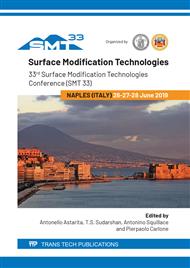p.7
p.13
p.19
p.25
p.31
p.37
p.43
p.49
p.55
The Impact of Formation of Oxide Layer on the Piston Crown Using Micro - Arc Oxidation on the Characteristics of the Spark Ignition Engine
Abstract:
In the present study, experiments were conducted to compare the effect of oxide layer formation on the piston crown coated using Micro-Arc Oxidation (MAO) with uncoated piston on the combustion and emission characteristics of the port injected Spark Ignition engine fueled by gasoline. The micro-arc oxidation (MAO) coating technique is the modern process to form a ceramic oxide layer on the reactive metal substrate (base metal) by electrochemical and electro-thermal oxidation in an alkaline electrolytic solution. Using MAO technique, an oxide layer of thickness 72 μm was formed on the piston crown. This oxide layer acts as a thermal barrier to reduce the in-cylinder heat rejection and increase the durability of the piston by withstanding high temperature and pressure produced during combustion. Combustion flames have been captured using the AVL combustion analyzer to analyze the development and propagation of flames within the engine cylinder. From the flame images, it was observed that propagation of flame was faster in MAO coated piston compared to uncoated piston. This is because of higher local temperature inside the combustion chamber that was resulted due to low thermal conductivity of MAO layer. It was also found that carbon monoxide (CO) and hydrocarbon (HC) emissions were reduced as a result of efficient fuel combustion, while NOx emissions increased because of increased combustion temperatures for MAO coated pistons. Keywords: Electro-thermal oxidation, Flame propagation, Micro-arc oxidation, Piston crown, Thermal barrie
Info:
Periodical:
Pages:
31-36
Citation:
Online since:
July 2019
Authors:
Price:
Сopyright:
© 2019 Trans Tech Publications Ltd. All Rights Reserved
Share:
Citation:


